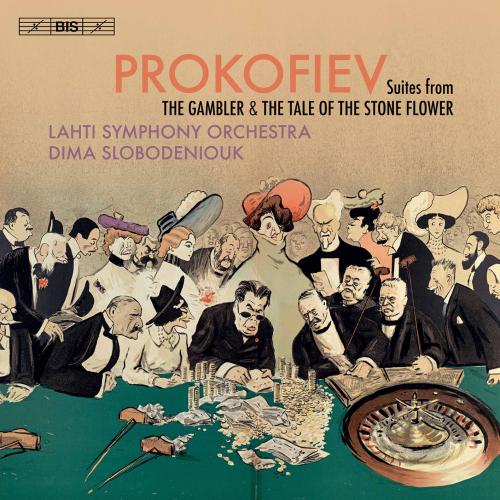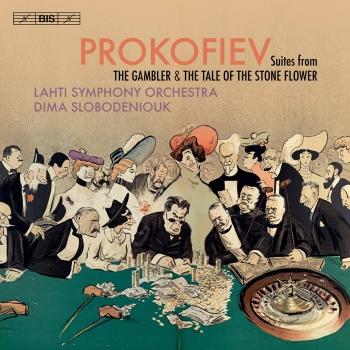
Prokofiev: Suites from The Gambler & The Tale of the Stone Flower Lahti Symphony Orchestra & Dima Slobodeniouk
Album info
Album-Release:
2020
HRA-Release:
03.04.2020
Label: BIS
Genre: Classical
Subgenre: Orchestral
Artist: Lahti Symphony Orchestra & Dima Slobodeniouk
Composer: Sergei Sergejewitsch Prokofjew
Album including Album cover Booklet (PDF)
- Sergei Prokofiev (1891 - 1953): The Gambler Suite, Op. 49:
- 1 The Gambler Suite, Op. 49: I. Alexis 05:11
- 2 The Gambler Suite, Op. 49: II. La grand'mère 06:26
- 3 The Gambler Suite, Op. 49: III. The General 02:59
- 4 The Gambler Suite, Op. 49: IV. Pauline 06:33
- 5 The Gambler Suite, Op. 49: V. Dénouement 04:38
- Sergei Prokofiev:
- 6 Autumnal, Op. 8 06:33
- 7 The Mistress of the Copper Mountain, Op. 129 04:14
- Wedding Suite, Op. 126:
- 8 Wedding Suite, Op. 126: I. Amorous Dance 06:21
- 9 Wedding Suite, Op. 126: II. Dance of the Fiancée's Girlfriends 02:00
- 10 Wedding Suite, Op. 126: III. Maidens' Dance 03:28
- Gypsy Fantasy, Op. 127:
- 11 Gypsy Fantasy, Op. 127: I. Introduction 00:35
- 12 Gypsy Fantasy, Op. 127: II. Gypsy Dance 02:17
- 13 Gypsy Fantasy, Op. 127: III. Severian's Dance 01:38
- 14 Gypsy Fantasy, Op. 127: IV. Dance of the Gypsy Girl 02:01
- 15 Gypsy Fantasy, Op. 127: V. Mass Dance 01:39
- Wedding Suite, Op. 126:
- 16 Wedding Suite, Op. 126: IV. Ceremonial Dance 01:59
- 17 Wedding Suite, Op. 126: V. Wedding Dance 03:00
Info for Prokofiev: Suites from The Gambler & The Tale of the Stone Flower
Throughout his career, Sergei Prokofiev wrote a large number of works for the stage – some of them highly successful, others less so. Whichever the case, Prokofiev would rarely miss the opportunity of recycling the score in one way or another – staying more or less close to the original in an orchestral suite or using it as material for a completely new work, such as the Third and Fourth symphonies (based on the ballet The Prodigal Son and the opera The Fiery Angel, respectively.) The present release combines suites created from Prokofiev’s very first opera (The Gambler, 1915–17) and his very last ballet (The Stone Flower, 1948–53). Based on a short novel by Dostoyevsky, The Gambler doesn’t have separate numbers that can easily be detached. Instead Prokofiev created ‘portraits’ of the four main characters, by re-assembling the music associated with them throughout the opera. The plot of The Tale of the Stone Flower was based on a collection of folk and fairy tales from mining communities of the Ural Mountains, and Prokofiev composed a 150-minute score in an idiom relying on folk elements and nineteenth-century musical traditions. While waiting for official permission to have the ballet performed, he planned a number of orchestral suites. On this recording, the Lahti Symphony Orchestra and their principal conductor Dima Slobodeniouk splice together two of these compilations: the Wedding Suite, Op.126 and the Gypsy Fantasy, Op.127, both of which were performed before the ballet itself, in 1951. The result is preceded by the opening of the actual ballet, entitled The Mistress of the Copper Mountain. These suites frame the brief Autumnal Sketch, one of the composer’s earliest acknowledged works for orchestra.
Lahti Symphony Orchestra
Dima Slobodeniouk, conductor
Dima Slobodeniouk
In Moskau geboren, erhielt Dima Slobodeniouk seine musikalische Ausbildung in Russland und Finnland. Seine Fähigkeit, die musikalischen Traditionen und den Ausdruck beider Länder zu vereinen, macht ihn zu einem der interessantesten Repräsentanten der jungen Dirigentengeneration.
Dima Slobodeniouk, seit 2013 Chefdirigent des Orquesta Sinfónica de Galicia und seit der Saison 2016/17 Principal Conductor des Lahti Symphony Orchestra sowie Artistic Director des Sibelius Festivals, wird von Publikum und Orchester gleichermaßen für seine künstlerische Arbeit hochgelobt. Er arbeitet mit renommierten Orchestern wie den Berliner Philharmonikern, dem Symphonieorchester des Bayerischen Rundfunks, Bayerischen Staatsorchester, Gewandhausorchester Leipzig, London Philharmonic Orchestra und London Symphony Orchestra sowie dem Royal Concertgebouw Orchestra.
Als Gastdirigent gibt Dima Slobodeniouk in der Saison 2019/20 beim NHK Symphony Orchestra und Tonhalle Orchester Zürich, bei den Wiener Symphonikern, beim San Francisco Symphony sowie The Cleveland Orchestra. Darüber hinaus folgt er Wiedereinladungen zum Boston Symphony Orchestra, Houston Symphony Orchestra, London Philharmonic Orchestra und Netherlands Radio Philharmonic Orchestra.
Zu den Solisten, mit denen Dima Slobodeniouk arbeitet, zählen Isabelle Faust, Patricia Kopatchinskaya, Leif Ove Andsnes, Khatia Buniatishvili, Vilde Frang, Baiba Skride, Yuja Wang und Peter Zimmerman.
Schon die Programme für die jeweilige Saisoneröffnung in Lahti und Galizien zeigen Dima Slobodeniouks weit gefächertes Repertoire. In Lahti stehen zur Feier des 20 jährigen Jubiläums des Sibelius-Festivals Werke des finnischen Nationalkomponisten auf dem Programm, für das Eröffnungskonzert in Galizien wählte Dima Slobodeniouk Strawinskys „Psalmensymphonie“.
Kürzlich veröffentlicht wurde eine Einspielung des Orquesta Sinfónica de Galicia und Ilya Gringolts mit Werken von Strawinsky für BIS, außerdem für selbiges Label eine Aufnahme mit Werken des Komponisten Aho und dem Lahti Symphony Orchestra, die 2018 mit den BBC Music Magazine Award ausgezeichnet wurde.
Slobodeniouk studierte von 1980-1989 Violine an der Zentralen Musikschule bei Z. Gilels und J. Chugajev. Er setzte sein Studium anschließend an den Konservatorien in Moskau und Mittelfinnland sowie an der Sibelius Akademie in Helsinki fort. 1994 nahm er zudem das Dirigierstudium auf und erhielt Unterricht von Atso Almila. Er vertiefte sein Studium an der Sibelius Akademie bei Leif Segerstam und Jorma Panula. Darüber hinaus studierte bei Ilja Musinin und Esa-Pekka Salonen. Um Nachwuchsförderung bemüht, gründete Dima Slobodeniouk gemeinsam mit dem Orquesta Sinfónica de Galicia ein Förderprogramm, das jungen Dirigiertalenten die Möglichkeit bietet, mit einem professionellen Orchester zu arbeiten.
Booklet for Prokofiev: Suites from The Gambler & The Tale of the Stone Flower














